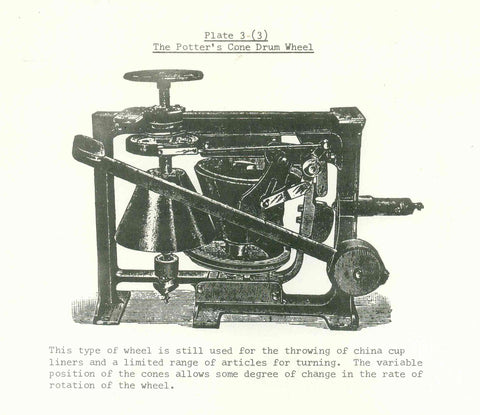On entering the Morris & James factory, one passes a rusting piece of Victorian machinery standing in a dusty alcove, like the statue of a household deity in a Roman villa. This is Anthony Morris’s throwing wheel (pictured below), purchased for five pounds in the early 1970’s from Henry Watson’s pottery in Wattisfield, U.K. Anthony used it originally in his pottery at Hoxne, and then brought it with him when he returned to New Zealand and founded Morris & James.
There is plenty of information available about the development of foot-driven throwing wheels, but the history of powered industrial wheels is difficult to find. Henry Doulton claimed to be the first potter to build a steam-powered throwing wheel at the Doulton Works in Lambeth, a decade before they became commercially available. This would probably have been in the early 1840’s. Another early powered wheel was produced by the Porteus Engineering Company of Glasgow.
I recently found an article from the December 1881 issue of the journal “The Engineer” posted on a local history website in Stoke on Trent. The article concerns the work of William Boulton (1825 – 1900), designer of Anthony Morris’s wheel. Boulton was born near to the village of Clayton (now absorbed into Newcastle under Lyme). His engineering company, founded in 1852 and still in business today, was a major contributor to the pre eminence of North Staffordshire in the British pottery industry. With regard to mechanized throwing wheels, his breakthrough was the introduction of a transmission method based on friction cones, which allowed the wheel speed to be varied by a factor of six – considerably more than earlier wheels. The position of the cones was controlled by a foot pedal, which allowed the potter to vary the speed while the pot was being formed. The 1881 article comments that the potter’s wheel is one of mankind’s earliest machines, yet until that date there had been remarkably little progress in industrializing the process. The author gives no reason for this, but in fact the technological difficulties were considerable. Structural changes take place in clay when it is subjected to stresses, that are variable and difficult to recognize. The worst aspect of this is that the results of the changes are often not apparent until the piece is fired and a reject results. In Victorian times, potters were only paid for what they produced after the items had emerged unscathed from the kiln. Boulton also patented machinery which produced cups and bowls by using a profile tool to force clay into a mould (jolleying). However, when a clay lacked plasticity, like bone china, it was necessary to form a blank by hand throwing and then to use the jolleying process to complete the shaping. Boulton’s cone drum wheels were still in use for this purpose right up to the 1960’s.
The drawing of the potter’s wheel accompanying the 1881 article (pictured below) shows a slightly different version from the Morris & James one. The cone drums have a smaller diameter, and they are set into a smaller frame.

Another contemporary drawing in my possession shows a version of similar size to the Morris & James one, fitted with a braking mechanism which may originally have been present on our machine (pictured below).

All the pots produced at Morris & James from the late 1970’s till the early 1980’s were made on the Boulton wheel. Anthony then realized that there was a potential market for large garden pots,- larger than would normally be made on a conventional throwing wheel. After many experiments, he adopted the idea of using a vertical extruder to form a cylindrical blank and then shaping this by hand. A different layout of throwing wheel was then required, where the potter would stand and reach down into the pot. The first of these new wheels was powered by a thyristor- controlled electric motor. When production volumes necessitated the use of two wheels, they were constructed with hydraulic motors. These gave the required high torque, simple speed control with valves, and incidentally kept the electrical components well away from the water – always a good plan.
- Mike Rose


